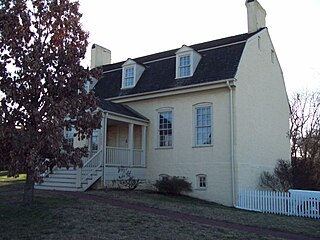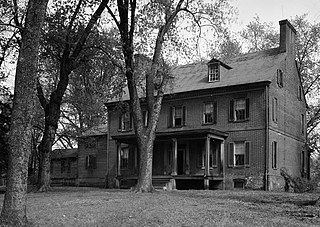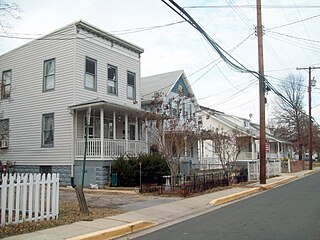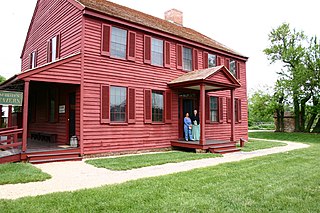
Darnall's Chance, also known as Buck House, Buck-Wardrop House, or James Wardrop House, is a historic home located at 14800 Governor Oden Bowie Drive, in Upper Marlboro, Prince George's County, Maryland, United States. It is named after Colonel Henry Darnall, a wealthy Roman Catholic planter, who was the Proprietary Agent of Charles Calvert, 3rd Baron Baltimore and who served for a time as Deputy Governor of the Province. The house itself was built c. 1742 by a merchant named James Wardrop, after he bought some of the land from Eleanor Darnall Carroll and her husband Daniel Carroll, a politician and wealthy planter. Today, Darnall's Chance houses the Darnall's Chance House Museum, an historic house museum which opened to the public in 1988.

Marietta, is a historic home located in Glenn Dale, Prince George's County, Maryland.

Oxon Cove Park and Oxon Cove Farm is a national historic district that includes a living farm museum operated by the National Park Service, and located at Oxon Hill, Prince George's County, Maryland. It is part of National Capital Parks-East. It was listed on the National Register of Historic Places in 2003.

Mount Pleasant is 2 1⁄2-story brick structure with a gambrel roof and is about two-thirds its original length. It is located near Upper Marlboro in Prince George's County, Maryland. Mount Pleasant was patented in 1697 to Richard Marsham, whose wife Anne was the daughter of Leonard Calvert, Governor of Maryland. Their grandson, Marsham Waring, inherited the home from his grandfather in 1713. His son, Richard Marsham Waring had a son, John, born in 1737 who inherited Mount Pleasant, and c. 1750, built the standing house. He died in 1813 and was buried at Mount Pleasant.

His Lordship's Kindness, also known as Poplar Hill, is a historic plantation estate on Woodyard Road east of Clinton, Maryland. It was built in the 1780s for Prince George's County planter Robert Darnall. The five-part Georgian mansion retains a number of subsidiary buildings including a slave's hospital and a dovecote. The property is now operated as a museum by a local nonprofit preservation group. It was designated a National Historic Landmark in 1970.

Snow Hill is a manor house located south of Laurel, Maryland, off Maryland Route 197, in Prince George's County. Built between 1799 and 1801, the 1 1/2-story brick house is rectangular, with a gambrel roof, interior end chimneys, and shed dormers. It has a center entrance with transom and a small gabled porch. A central hall plan was used, with an elaborate interior and corner cupboards. The original south wing was removed and rebuilt, and the home restored in 1940. The Late Georgian style house was the home of Samuel Snowden, part owner of extensive family ironworks, inherited from his father Richard Snowden. and is now owned and operated by the Maryland-National Capital Park and Planning Commission as a rental facility.

Bostwick is a historic home located a short distance, below Lowndes Hill, the present-day property, of Bladensburg Elementary School, in Bladensburg, Prince George's County, Maryland, United States. According to its date plaque, it was built in 1746 by Christopher Lowndes (1713-1785). The house was later the home of Lowndes’ son-in-law, Benjamin Stoddert (1751-1813), first Secretary of the Navy. Colonel Thomas H. Barclay resided at "Bostwick," the oldest surviving structure at Bladensburg. Located nearby is the Market Master's House, also built by Lowndes.

The William Hilleary House, or Hilleary-Magruder House, is a historic home located at Bladensburg in Prince George's County, Maryland, United States. The house is the only 18th-century stone, gambrel-roofed house in Prince George's County. It is now surrounded to the south and west by an exit ramp connecting Kenilworth Avenue with Annapolis Road.

The National Archives Site is an archeological site at the National Archives facility in College Park, Prince George's County, Maryland. The site contains archeological remains from prehistoric settlements during the Late Archaic period, c. 4000-1500 B.C. Stone artifacts recovered through archeological testing indicate that this camp served as a place of stone tool manufacture and probably as a staging point for hunting and foraging. Physical integrity of the prehistoric component is high, with little plow disturbance or admixture with artifacts from other periods. The presence of a small number of other artifacts, including the projectile points, a spokeshave, and utilized flakes, indicates that the site also served in other hunting and foraging pursuits. It is one of a relatively small percentage of known prehistoric properties in Maryland with undisturbed archeological deposits.

Ash Hill, or Hitching Post Hill, is a two-story brick dwelling erected ca. 1840, and located on Rosemary Lane, in Hyattsville, Prince George's County, Maryland. The house was built by Robert Clark, an Englishman who was seeking space and quiet in contrast to the crowded city of Washington, D.C. In 1875, General Edward Fitzgerald Beale bought the property. Beale entertained luminaries such as President U.S. Grant, President Grover Cleveland and Buffalo Bill Cody. The house, with its foot-thick brick walls and hilltop site, is an imposing one, made even more so by the massive pillared porch which surrounds it on three sides. The porch was added by Admiral Chauncey Thomas who purchased the property in 1895.

Bowieville is a historic home located near Upper Marlboro in Prince George's County, Maryland, United States. It is an elegant two-part plantation house of the late Federal style, built of brick and covered with stucco. The architectural detail is transitional between the Federal and Greek Revival styles.

Concord is a historic home located in District Heights, Prince George's County, Maryland. It is a 1790s 2 1⁄2-story Flemish bond brick house with a five-bay south facade, and a later two-part wing which stretches to the west. The home was built for Zachariah Berry, Sr. (1749-1845), a prosperous planter who had large landholdings in Maryland, the District of Columbia, and Kentucky. A great deal of the home's features are Greek Revival-influenced, dating from an 1860s renovation. A family cemetery and a number of 20th century outbuildings are located on the property.

Melwood Park is a historic home located near Upper Marlboro in Prince George's County, Maryland, United States. It is a 2 1⁄2-story, Flemish bond brick structure, with Georgian details. As of 2009, it is undergoing an extensive restoration. This unique dwelling was visited by George Washington on several occasions and the British Army camped here during their march to Washington, D.C. in August 1814, during the War of 1812.
Nottingham is a small town on the Patuxent River in Prince George's County, Maryland. It contains an archaeological site listed on the National Register of Historic Places in 1975.

The North Brentwood Historic District, is a national historic district located in the town of North Brentwood, Prince George's County, Maryland. It was the earliest incorporated African American community in the county. The historic district comprises 128 buildings reflecting its development over the period from 1891 to 1950. All of the early vernacular dwellings were of wood frame construction with Late Victorian inspiration. The 1920s house forms represented included bungalows, multi-family houses, and larger Foursquares. Small brick cottages were primarily built in the period immediately following World War II. The surviving historic buildings illustrate the forms and styles of buildings typically constructed in working-class suburban communities of the period.
Walker Prehistoric Village Archeological Site is an archeological site located near Poolesville, Montgomery County, Maryland. The site is a large Late Woodland village located on Selden Island in the Potomac River. Excavations carried out in the 1930s and 1940s revealed a 40-foot section of a palisade, circular house patterns, shallow oval pits and cylindrical pits, and flexed burials interred in the floors of the houses.
The Katcef Archeological Site is an archaeological site near Crofton in Anne Arundel County, Maryland. It is a series of overlapping base camp sites dating from the Clovis phase of the Paleoindian period, through to the Late Woodland period. The primary era of site utilization was during the Late Archaic period.
The Magothy Quartzite Quarry Archeological Site is an archaeological site near Pasadena in Anne Arundel County, Maryland. The site consists of several large outcroppings of quartzite and sandstone, that may have been utilized by prehistoric Native American groups as early as the Middle Archaic period, if not earlier.

St. Francis Xavier Church and Newtown Manor House Historic District is the first county designated historic district in Saint Mary's County, the "Mother County" of Maryland and is located in Compton, Maryland, near the county seat of Leonardtown. The district marks a location and site important in the 17th century ecclesiastical history of Maryland, as an example of a self-contained Jesuit community made self-supporting by the surrounding 700-acre (2.8 km2) farm. The two principal historic structures were added to the National Register of Historic Places in 1972. Archaeological remains associated with the site date back to the early colonial period, mid-17th century.

The George Markell Farmstead, also known as Arcadian Dairy Farm and the Thomas Property, is a historic home and farm complex located at Frederick, Frederick County, Maryland, United States. It consists of brick house built about 1865, a brick smokehouse, a bake oven, two stone domestic outbuildings, an ice house, a springhouse, a frame stable, a frame chicken house, a mid-20th century guest house, and various sheds and outbuildings. Nearby is a large gambrel-roofed concrete block barn. The main house has combined Greek Revival and Italianate stylistic influences. The once large Markell dairy farm, with its lane to the Ballenger Creek ford of the Monocacy River, served as the primary approach route to the battlefield by Confederate troops during the July 9, 1864 Battle of Monocacy during the American Civil War.























